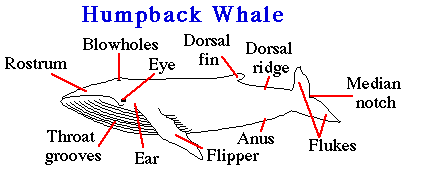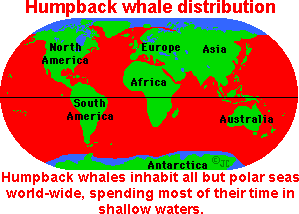Advertisement.
EnchantedLearning.com is a user-supported site.
As a bonus, site members have access to a banner-ad-free version of the site, with print-friendly pages.
Click here to learn more.
(Already a member? Click here.)

GENERAL DESCRIPTION
The humpback whale is a baleen whale and a rorqual whale that sings amazing songs. It performs complex and cooperative feeding techniques. The humpback has a bulky head with bumpy protuberances (tubercles), each with a bristle. Humpbacks are acrobats of the ocean, breaching and slapping the water. They live in pods and have 2 blowholes. The name humpback describes the motion it makes as it arches its back out of the water in preparation for a dive.
SIZE
Humpback whales grow to be about 52 feet (16 m) long, weighing 30-50 tons (27-45 tonnes). The females are slightly larger than males, as with all baleen whales. The four-chambered heart of the average humpback whale weighs about 430 pounds (195 kg) - about as much as three average adult human beings.
SKIN, SHAPE AND FINS
 Humpbacks come in 4 different color schemes, ranging from white to gray to black to mottled. There are distinctive patches of white on underside of the flukes (tail). These markings are unique to each individual whale, like a fingerprint. The humpback's skin is frequently scarred and may have patches covered with barnacles.
Humpbacks come in 4 different color schemes, ranging from white to gray to black to mottled. There are distinctive patches of white on underside of the flukes (tail). These markings are unique to each individual whale, like a fingerprint. The humpback's skin is frequently scarred and may have patches covered with barnacles.
Humpback whales have 14-35 throat grooves that run from the chin to the navel. These grooves allow their throat to expand during the huge intake of water during filter feeding. They have small, round bumps on the front of the head (called knobs or tubercles), edging the jaws.
Humpbacks have huge, mottled white flippers with rough edges that are up to one-third of its body length; these are the largest flippers of any whale. The humpback's genus, Megaptera, means "huge-wings," referring to its flippers. The flippers may have barnacles growing on them.
The deeply-notched flukes (tail) are up to 12 feet (3.7 m) wide. Humpbacks have a small dorsal fin toward the flukes.
DIET AND BALEEN
Humpback whales (like all baleen whales) are seasonal feeders and carnivores that filter feed tiny crustaceans (krill - mainly Euphausia superba, copepods, etc.), plankton, and small fish (including herring, mackerel, capelin, and sandeel) from the water. They are gulpers (not skimmers), filter feeders that alternatively swim then gulp a mouthful of plankton or fish. Concentrated masses of prey are preferable for this method of feeding. An average-sized humpback whale will eat 4,400-5,500 pounds (2000-2500 kg) of plankton, krill and small, schooling fish each day during the feeding season in cold waters (about 120 days). They eat twice a day.
 Humpbacks cooperate in hunting and have developed a method of rounding up highly concentrated masses of prey that is called bubble-net feeding. The hunting members of a pod form a circle 10-100 feet (3.1-31 m) across and about 50 feet (15 m) under the water. Then the humpbacks blow a wall of bubbles as they swim to the surface in a spiral path. The cylindrical wall of bubbles makes the trapped krill, plankton, and/or small fish move to the surface of the water in a giant, concentrated mass. The humpbacks then eat a large, hearty meal.
Humpbacks cooperate in hunting and have developed a method of rounding up highly concentrated masses of prey that is called bubble-net feeding. The hunting members of a pod form a circle 10-100 feet (3.1-31 m) across and about 50 feet (15 m) under the water. Then the humpbacks blow a wall of bubbles as they swim to the surface in a spiral path. The cylindrical wall of bubbles makes the trapped krill, plankton, and/or small fish move to the surface of the water in a giant, concentrated mass. The humpbacks then eat a large, hearty meal.
The humpback whale has about 330 pairs of dark gray baleen plates with coarse gray bristles hanging from the jaws. They are about 25 inches (0.6 m) long and 13.5 inches (34 cm) wide.
SOCIAL GROUPS






Humpbacks travel in large, loose groups. Most associations between humpbacks are temporary, lasting at most a few days. The exception is the strong and lasting bond between mother and calves.
DIVING, BREACHING, SPYHOPPING, AND LOBTAILING
Humpback whales can dive for up to 30 minutes, but usually last only up to 15 minutes. Humpbacks can dive to a depth of 500-700 feet (150-210 m).
 Humpbacks are very acrobatic, often breaching high out of the water and then slapping the water as they come back down. Sometimes they twirl around while breaching. Breaching may be purely for play or may be used to loosen skin parasites or have some social meaning.
Humpbacks are very acrobatic, often breaching high out of the water and then slapping the water as they come back down. Sometimes they twirl around while breaching. Breaching may be purely for play or may be used to loosen skin parasites or have some social meaning.
 Spyhopping is another humpback activity in which the whale pokes its head out of the water for up to 30 seconds to take a look around.
Spyhopping is another humpback activity in which the whale pokes its head out of the water for up to 30 seconds to take a look around.
 Humpbacks also stick their tail out of the water into the air, swing it around, and then slap it on the water's surface; this is called lobtailing. It makes a very loud sound. The meaning or purpose of lobtailing is unknown, but may be done as a warning to the rest of the pod. Humpbacks lobtail more when the seas are rough and stormy. Slapping a fin against the surface of the water is another unexplained humpback activity.
Humpbacks also stick their tail out of the water into the air, swing it around, and then slap it on the water's surface; this is called lobtailing. It makes a very loud sound. The meaning or purpose of lobtailing is unknown, but may be done as a warning to the rest of the pod. Humpbacks lobtail more when the seas are rough and stormy. Slapping a fin against the surface of the water is another unexplained humpback activity.
SPOUTING - BREATHING
 Humpback whales breathe air at the surface of the water through 2 blowholes located near the top of the head. They spout (breathe) about 1-2 times per minute at rest, and 4-8 times per minutes after a deep dive. Their blow is a double stream of spray that rises 10-13 feet (3.1-4 m) above the surface of the water.
Humpback whales breathe air at the surface of the water through 2 blowholes located near the top of the head. They spout (breathe) about 1-2 times per minute at rest, and 4-8 times per minutes after a deep dive. Their blow is a double stream of spray that rises 10-13 feet (3.1-4 m) above the surface of the water.
SPEED
Humpback whales normally swim 3-9 mph (4.8-14 kph), but can go up to 15-16.5 mph (24-26.5 kph) in bursts when in danger. Feeding speeds are slower, about 1.2-3.5 mph.
VOCALIZATION
Humpback whales are the noisiest and most imaginative whales when it comes to songs. They have long, varied, complex, eerie, and beautiful songs that include recognizable sequences of squeaks, grunts, and other sounds. The songs have the largest range of frequencies used by whales, ranging from 20-9,000 Hertz. Only males have been recorded singing. They sing the complex songs only in warm waters, perhaps used for mating purposes. In cold waters, they make rougher sounds, scrapes and groans, perhaps used for locating large masses of krill (the tiny crustaceans that they eat).
HABITAT AND RANGE
Humpback whales live at the surface of the ocean, both in the open ocean and shallow coastline waters. When not migrating, they prefer shallow waters. They migrate from warm tropical waters where they breed and calve to arctic waters where they eat.
There are 3 separate populations of humpbacks, those living in the North Pacific Ocean, those in the North Atlantic Ocean, and those roving the oceans of the Southern Hemisphere.

MIGRATION
Humpback whales take long seasonal migrations. They mate and calve in tropical waters during the winter and then travel to cold polar waters during the summer to feed. During the summer in the warm waters, adults do not eat, but live off their layer of blubber (fat); the young calves feed on rich mother's milk.
Humpbacks migrate at 3-9 mph (4.8-14 kph). They have incredible powers of endurance, traveling over 3,100 miles (5000 km) during each seasonal migration with almost no rest along the way. During migrations, they cover over 1,000 miles per month.
REPRODUCTION
Humpback whale breeding occurs mostly in the winter to early spring while near the surface and in warm, tropical waters. The gestation period is about 11-12 months and the calf is born tail first (this is normal for cetaceans) and near the surface in warm, shallow waters. The newborn instinctively swims to the surface within 10 seconds for its first breath; it is helped by its mother, using her flippers. Within 30 minutes of its birth the baby whale can swim. The newborn calf is about 14 feet long (4.3 m) and weighs about 2.5 tons (2.3 tonnes). Twins are extremely rare (about 1% of births); there is almost always one calf. The baby is nurtured with its mother's milk and is weaned in about 11 months. The mother and calf may stay together for a year or longer. Calves drink 100 pounds of milk each day. Humpback whales reach puberty at 4-7 years old, and maturity at 15 years. A calf is born to a female every 1-3 years.
LIFE SPAN
Humpback whales have a life expectancy of 45-50 years.
POPULATION COUNT
It is estimated that there are over 10,000-15,000 humpback whales world-wide. Humpback whales are an endangered species.
CLASSIFICATION
Humpback whales (Megaptera novaeangliae) are baleen whales (Suborder Mysticeti). They are one of 76 cetacean species, and are marine mammals.
Kingdom Animalia (animals)
Phylum Chordata (vertebrates)
Class Mammalia (mammals)
Order Cetacea (whales and dolphins)
Suborder Mysticeti (baleen whales)
Family Balaenopteridae
Genus Megaptera
Species novaeangliae |
 |
HUMPBACK WHALE ACTIVITIES
A print-out about Humpback whales.
A first grade addition activity. Solve the 1-digit addition problems, then do letter substitutions to answer the humpback whale question.
A first grade subtraction activity. Solve the 1-digit subtraction problems, then do letter substitutions to answer the humpback whale questions.
A Humpback whale word hunt activity - For second and third graders.
HUMPBACK WHALE LINKS
The Virtual Whale Project, learn about humpback whales, from Simon Fraser University, British, Columbia, Canada.
Humpback whale songs - Real Audio sound file of a humpback whale from the Center for Coastal Studies.
Baby whale story, the birth of a humpback whale from the International Wildlife Coalition.
Information Sheets About Whales
(and other cetaceans) |
Just click on a cetacean's name to go to that information sheet.
Enchanted Learning®
Over 35,000 Web Pages
Sample Pages for Prospective Subscribers, or click below
Click to read our Privacy Policy
Enchanted Learning Search
|
Search the Enchanted Learning website for:
|
Advertisement.
Advertisement.
Copyright ©1998-2018
EnchantedLearning.com ------ How to cite a web page

